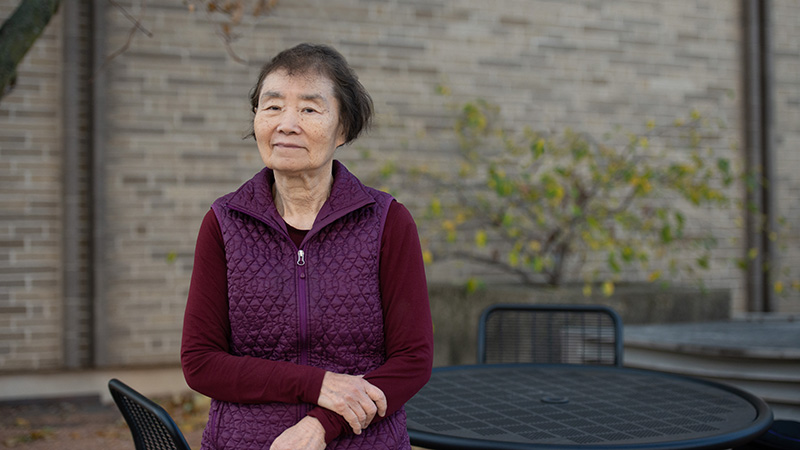
Since December 1973 — 50 years this month — Ei Terasawa Grilley, PhD, has worked as a scientist with the Wisconsin National Primate Research Center (WNPRC). She has also served as professor in the Department of Pediatrics Division of Endocrinology and Diabetes since 1997.
The WNPRC research scientists have made many consequential and beneficial discoveries. As one of the current 26 research scientists with core research support from the center, Terasawa has long focused her research efforts on the mechanisms of puberty onset through investigations of cellular and molecular properties of gonadotropin-releasing hormones (GnRH) neurons in the hypothalamus. Absence of GnRH neurons or abnormality in the system result in idiopathic hypogonadotropic hypogonadism (IHH), a disease characterized by delayed or absent sexual development. The GnRH neuron in the hypothalamus is the top of the cascade regulating the synthesis and release of pituitary gonadotropins (luteinizing hormone and follicle stimulating hormone), both of which are essential for cyclic ovulation in females and spermatogenesis in males.
For many years Terasawa has been investigating the mechanism of puberty onset in non-human primates, as a model for humans. Specifically, GnRH neurons are mature at birth, but it takes more than a decade until puberty occurs. Why? Terasawa has been addressing the hypothesis that a hypothalamic inhibition established during the late-neonatal period suppresses activity of GnRH neurons until the time of puberty. Then, the question is, at the onset of puberty, does withdrawal of hypothalamic inhibition occur first, or does a signal from kisspeptin neurons that regulate GnRH neural activity overcome the hypothalamic inhibition?
One recent aspect of Terasawa’s work has been generation of human GnRH neurons with embryonic stem cells (ESC) and induced pluripotent stem cells (iPSC) — in addition to work with existing non-human primate models — in order to more quickly and effectively investigate their properties. Through multidisciplinary approaches, these investigations will likely provide potential treatment tools for IHH patients.
The protective properties of estradiol in cognitive aging is another of Terasawa’s research interests. The deleterious effects of estradiol decline with age, such as cognitive loss and sleep changes, have been shown in rodent and non-human models. Her further research in this area, such as a pilot study supported by the Wisconsin Alzheimer’s Disease Research Center, may provide steps toward knowledge and methods that could reduce the incidence of Alzheimer’s disease, Parkinson’s disease, and other age-related dementia and cognitive decline.
Terasawa has continued with her research after so many years because she loves her work. It is the reason that she became a scientist in the first place. As a young student in Japan in the 1960s, she was drawn to science and the intellectual challenges of research. “I loved science and loved to study,” she said. “I didn’t want to stop.” A professor who recognized her talent and motivation offered her a place in a PhD program in the Yokohama City University Medical School.
Terasawa earned a PhD in medical physiology, and then was accepted for a year-long fellowship as a research physiologist at the University of California, Berkeley. The next year, she was a research fellow in the department of anatomy at the University of California, Los Angeles. She published three research papers during each of her two fellowships. Six papers in two years was a prodigious output, and her work was noticed. She became an instructor and soon an assistant professor in the Department of Physiology, Yokohama City University School of Medicine in Yokohama, Japan. A few years later, when a more challenging opportunity for a scientist appeared in the then regional, now national, primate research center in Madison, Wisconsin, Terasawa was selected in 1973 as an associate scientist for the center. In 1980 she was promoted to the rank of senior scientist in the WNPRC.
In the WNPRC position, Terasawa dedicated herself to research in neuroendocrinology, following new paths of inquiry as they opened to her. Her research with various groups has resulted in more than 238 published papers. Terasawa has also taught incoming groups of future physicians and scientists. Beginning in 1980, she has been teaching graduate courses in the Neuroscience Training Program, as well as in the Endocrinology and Reproductive Physiology Training program, continuing to today. In 1997, when she joined the Department of Pediatrics, she added teaching the graduate seminar course “Special Topics in Neuroendocrinology” during most spring semesters until 2011.
With robust research grant support throughout her career, she has continued to seek research funding as her various research projects continue. In addition, she has been a referee for more than 60 scientific journals for manuscript publications and grant reviews. Terasawa has received scores of honors and awards, served on numerous boards and committees, and has presented lectures and talks at conferences around the world. Since 1974, she has supported and advised more than 150 fellows, graduate students, and undergraduate students: many have taken on the role of physician, researcher, or other positions in science and biotechnology.
For 50 years at the University of Wisconsin, Terasawa has pursued her scientific research. She has contributed greatly as a researcher, teacher, and expert wherever her knowledge can be of service. Her discoveries have improved approaches to diagnosing and treating puberty disorders and other neuroendocrine disorders, while her influence on students and trainees will continue for decades to come.
Photo by Bob Gordon/Department of Pediatrics